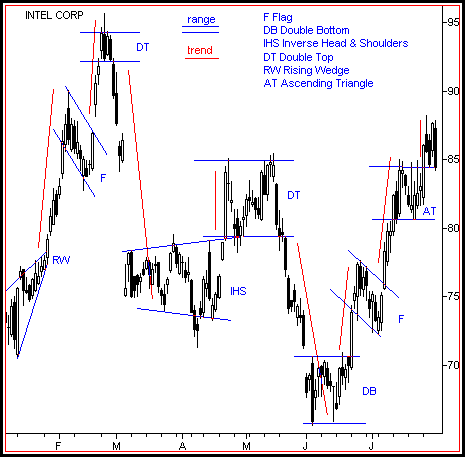|
Home
Up
New Page 10
Co-brand
Partnerships





| |
|
The
Traders Wheel
8/22/98 by Alan Farley |
|
Trend-Range
Axis
Do you see order in price movement? Can
you identify and trade with the flow? When opportunity appears, are you
ready to act?
All markets tend to cycle between
constricted range and directional trend in all time frames. Organize your
market knowledge and trading strategy along this important trend-range
axis. When breakouts erupt, follow the skills of the momentum trader. But
recognize when price contracts and predictable patterns emerge. Use these
repeating formations to execute the contrary tactics of the swing trader.
Find your place on the trend-range axis
with these key observations:
- Price movement demonstrates both
directional trend and non-directional range activity.
- Range motion alternates with trend
movement.
- Trends are classified by their upward
or downward bias.
- Trends change and reverse at certain
complex points of development.
- Movement out of ranges will either
continue the existing trend or reverse it.
- Ranges are classified by their
repeating patterns, bias for continuation or reversal and the trends
expected to follow them.
- Range volatility is highest at the
interface between the prior trend and inception point of the new
pattern.
- Range volatility is lowest at the
apex point just prior to inception of the new trend.
- High range volatility is
characterized by wide range bars, high volume and low ROC (Rate of
Change).
- Low range volatility is characterized
by narrow range bars, low volume and low ROC.
- Ranges exist in a state of negative
feedback where price movement pulses between minimum and
maximum points but does not build direction (momentum).
- Trends exist in a state of positive
feedback where price movement builds incrementally in a single
direction.
- Breakouts from patterns are
characterized by their shift from a state of negative feedback to
positive feedback.
- Non-directional price movement arises
from a state of high volatility associated with the end of positive
feedback.
- Directional price movement arises
from a state of low volatility associated with the end of negative
feedback.
- Negative feedback registers on
oscillators as shifts between overbought and oversold states but does
not register on momentum gauges.
- Positive feedback registers on
momentum indicators as directional movement but gives false readings
on oscillators.
 |
| The market pendulum swings back
and forth endlessly between trend and range. Over and over again,
price completes a thrust and then pauses to test the boundaries of
the new level. Similar patterns develop constantly in these
constricted zones, allowing profitable entries through early
recognition. Use custom trading rules to capitalize on the
characteristics of each unique formation. |
|
| |
|
Alan Farley is a full-time trader and
author residing in Denver, CO. He
publishes The
Hard Right Edge premier web
site for trader education, technical analysis and trader resources
featuring both Morning Trader and Traders Workshop. The site provides
traders with comprehensive resources including original tactics and
strategies on multi-trend technical analysis and short-term trading .
Alan also authors on-line training technical analysis in association with
independent sites. His most recent publications include the Mastering
The Trade on-line workshop, Momentum: Riding The Tiger, and Time of
Day. In addition to writing, he is an outstanding speaker and lecturer on
short term trading strategies.
He has been featured in Barrons, Smart
Money magazine, Tech Week, MoneyCentral and TheStreet.com.
|
| |
|
|
